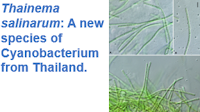Archaeans are Prokaryotic micro-organisms resembling Bacteria, but only distantly related to them, and more closely related to Eukaryotes. The Methanomicrobiales are a group of Archaeans which produce methane through reductive reactions, typically obtaining carbon from carbon dioxide, although there are some exceptions. Members of the genus Methanofollis, for example, produce methane by the reduction of alcohols, typically using acetate as a carbon-donor.
In a paper published in the journal Archives of Microbiology on 13 August 2022, Linda Dengler, Julia Meier, Felix Grünberger, and Annett Bellack of the Institute of Microbiology and Archaea Centre at the University of Regensburg, Reinhard Rachel of the Electron Microscopy Center at the University of Regensburg, and Dina Grohmann and Harald Huber, also of the Institute of Microbiology and Archaea Centre at the University of Regensburg, describe a new species of Methanofollis from an oil well in Costa Rica.
The new species was isolated from an exploratory drill well sunk in the Cahuita National Park, on the southwestern Atlantic coast of Costa Rica. The well is now a stagnant pool, with the new species being taken from an anaerobic layer 30 cm beneath the surface.
Ancient oil well in the Cahuita National Park, Costa Rica, original sampling site of strain CaP3V-MF-L2AT. Dengler et al. (2022).
The new species, initially identified as strain CaP3V-MF-L2AT, was found to be able to metabolise propanol with acetate producing methane. It was unable to metabolise acetate on its own, nor acetate with methanol, ethanol, butanol, or cyclopentanol. It was found by genetic analysis to be a new species within the genus Methanofollis, and given the specific name propanolicus, in reference to its obligate metabolising of propanol.
(a) Transmission electron micrograph of freeze-etched cells of
strain CaP3V-MF-L2AT indicating (b) proteinaceous S-Layer (SL) and
an archaellum (AR). Scale bars are 200 nm. Dengler et al. (2022).
Cells of Methanofollis propanolicus are irregularly coccoid (roughly spherical), 0.8–1.8 μm in diameter, and found singularly or in pairs. They are have two types of appendages; archaella (a filament attached to the cell membrane by a molecular motor, used to propel some forms of Archaea in a swimming-like motion) with a diameter of about 12 nm, and pili (hair-like structures found on both Bacteria and Archaea, which can have a variety of functions), with diameters of about 8 nm.
Transmission electron
micrograph of Pt/C shadowed
cells of strain CaP3V-MF-L2AT
show the great variability in
cell-shape as well as archaella. Scale bar is 400 nm. Dengler et al. (2022).
Although only propanol and acetate were necessary for the survival of Methanofollis propanolicus, the species did better in the presence of yeast-extract. It was able to grow at temperatures of 25-40°C, with optimum growth at 37°C. The species was able to tolerate salinities in the range 0-2.5% weight/volume sodium chloride, with optimum growth at 0.2-1.5%. Methanofollis propanolicus was able to grow at pH values in the range 6.0-7.5, with optimum growth in the range 6.5-7.0.
See also...









